Bridge abutments
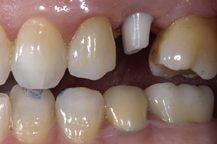
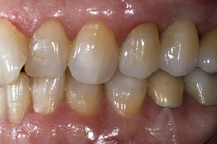
Dental bridge abutments are made such that the path of insertion of the teeth involved is nearly parallel with each other.
In dentistry, an abutment is a connecting element. [1] This is used in the context of a fixed bridge (the "abutment teeth" referring to the teeth supporting the bridge), partial removable dentures (the "abutment teeth" referring to the teeth supporting the partial) and in implants (used to attach a crown, bridge, or removable denture to the dental implant fixture). The implant fixture is the screw-like component that is osseointegrated.


Dental bridge abutments are made such that the path of insertion of the teeth involved is nearly parallel with each other.
Partial denture abutments [2] are unique in that they may incorporate elements such as rest seats, guide planes, and recontouring.
These are usually called prosthetic implant abutments and are responsible for making the connection between the prosthesis and the implant. [3] These abutments can be made from a variety of materials, such as titanium, surgical stainless steel, gold and zirconia.
The adjacent images show how a ceramic abutment can enhance a ceramic crown by giving it a more lifelike appearance. Ceramic abutments have to be used with care, however, since their compressive strength is nowhere near that of titanium, gold or other noble metals. Most clinicians feel more comfortable using a metal prosthetic abutment in the posterior molar areas, due to the increased masticatory forces present in these areas.
An abutment is not necessarily parallel to the long axis of the implant. It is utilized when the implant is at a different inclination in relation to the proposed prosthesis. Most crowns and fixed partial dentures have a cemented or screw-retained fixation on the abutment.

In a three-piece implant the abutment is fixed on the implant with a screw butt joint. [4] This screw needs to be tightened to a predetermined torque with a dental torque wrench, in order to avoid screw loosening during chewing, which can often create a counter-clockwise torque on the implant-abutment interface, encouraging the abutment screw to come loose. This can largely be prevented with proper screw design and torquing of the abutment.
In a two-piece implant the abutment is morse tapered or cold welded on the implant. Microbial leakage and colonization between the implant and the abutments can result in inflammatory reactions and crestal bone loss. Morse taper conical abutments showed a cumulative implant survival rate of 98.23% [5] in terms of seal performance, microgap formation, torque maintenance, and abutment stability. [6]
A one-piece implant incorporates the trans-mucosal abutment as an integral part of the implant. [7] This type of implant is often used with a flapless procedure and immediate loading (the crown is placed a short time after placing the implant). [8]

Dentures are prosthetic devices constructed to replace missing teeth, supported by the surrounding soft and hard tissues of the oral cavity. Conventional dentures are removable. However, there are many denture designs, some of which rely on bonding or clasping onto teeth or dental implants. There are two main categories of dentures, the distinction being whether they fit onto the mandibular arch or on the maxillary arch.

Dental surgery is any of a number of medical procedures that involve artificially modifying dentition; in other words, surgery of the teeth, gums and jaw bones.

A bridge is a fixed dental restoration used to replace one or more missing teeth by joining an artificial tooth definitively to adjacent teeth or dental implants.

A dental technician is a member of the dental team who, upon prescription from a dental clinician, constructs custom-made restorative and dental appliances.

A dental implant is a prosthesis that interfaces with the bone of the jaw or skull to support a dental prosthesis such as a crown, bridge, denture, or facial prosthesis or to act as an orthodontic anchor. The basis for modern dental implants is a biological process called osseointegration, in which materials such as titanium or zirconia form an intimate bond to the bone. The implant fixture is first placed so that it is likely to osseointegrate, then a dental prosthetic is added. A variable amount of healing time is required for osseointegration before either the dental prosthetic is attached to the implant or an abutment is placed which will hold a dental prosthetic/crown.

In dentistry, a crown or a dental cap is a type of dental restoration that completely caps or encircles a tooth or dental implant. A crown may be needed when a large dental cavity threatens the health of a tooth. A crown is typically bonded to the tooth by dental cement. They can be made from various materials, which are usually fabricated using indirect methods. Crowns are used to improve the strength or appearance of teeth and to halt deterioration. While beneficial to dental health, the procedure and materials can be costly.
Prosthodontics, also known as dental prosthetics or prosthetic dentistry, is the area of dentistry that focuses on dental prostheses. It is one of 12 dental specialties recognized by the American Dental Association (ADA), Royal College of Surgeons of England, Royal College of Surgeons of Edinburgh, Royal College of Surgeons of Ireland, Royal College of Surgeons of Glasgow, Royal College of Dentists of Canada, and Royal Australasian College of Dental Surgeons. The ADA defines it as "the dental specialty pertaining to the diagnosis, treatment planning, rehabilitation and maintenance of the oral function, comfort, appearance and health of patients with clinical conditions associated with missing or deficient teeth or oral and maxillofacial tissues using biocompatible substitutes."
A removable partial denture (RPD) is a denture for a partially edentulous patient who desires to have replacement teeth for functional or aesthetic reasons and who cannot have a bridge for any reason, such as a lack of required teeth to serve as support for a bridge or financial limitations.
Anodontia is a rare genetic disorder characterized by the congenital absence of all primary or permanent teeth. It is divided into two subsections, complete absence of teeth or only some absence of teeth. It is associated with the group of skin and nerve syndromes called the ectodermal dysplasias. Anodontia is usually part of a syndrome and seldom occurs as an isolated entity. There is usually no exact cause for anodontia. The defect results in the dental lamina obstruction during embryogenesis due to local, systemic and genetic factors.

Toothlessness, or edentulism, is the condition of having no teeth. In organisms that naturally have teeth, it is the result of tooth loss.
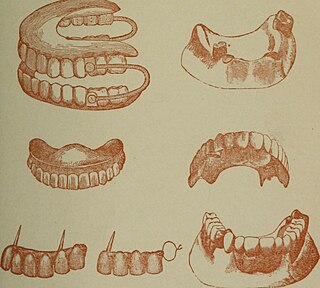
A denturist in the United States and Canada, clinical dental technologist in the United Kingdom and Ireland, dental prosthetist in Australia, or a clinical dental technician in New Zealand is a member of the oral health care team and role as primary oral health care provider who provides an oral health examination, planning treatment, takes impressions of the surrounding oral tissues, constructs and delivers removable oral prosthesis treatment directly to the patient.
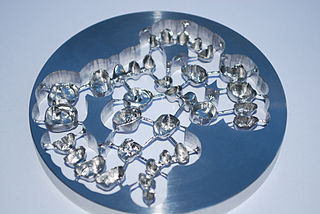
CAD/CAM dentistry is a field of dentistry and prosthodontics using CAD/CAM to improve the design and creation of dental restorations, especially dental prostheses, including crowns, crown lays, veneers, inlays and onlays, fixed dental prostheses (bridges), dental implant supported restorations, dentures, and orthodontic appliances. CAD/CAM technology allows the delivery of a well-fitting, aesthetic, and a durable prostheses for the patient. CAD/CAM complements earlier technologies used for these purposes by any combination of increasing the speed of design and creation; increasing the convenience or simplicity of the design, creation, and insertion processes; and making possible restorations and appliances that otherwise would have been infeasible. Other goals include reducing unit cost and making affordable restorations and appliances that otherwise would have been prohibitively expensive. However, to date, chairside CAD/CAM often involves extra time on the part of the dentist, and the fee is often at least two times higher than for conventional restorative treatments using lab services.
Fixed prosthodontics is the branch of prosthodontics that focuses on dental prosthesis that are permanently affixed (fixed). Crowns, bridges, inlays, onlays, and veneers are some examples of indirect dental restorations. Prosthodontists are dentists who have completed training in this specialty that has been recognized by academic institutes. Fixed prosthodontics can be used to reconstruct single or many teeth, spanning tooth loss areas. The main advantages of fixed prosthodontics over direct restorations are improved strength in big restorations and the possibility to build an aesthetic-looking tooth. The concepts utilised to select the suitable repair, as with any dental restoration, include consideration of the materials to be used, the level of tooth destruction, the orientation and placement of the tooth, and the condition of neighboring teeth

A dental prosthesis is an intraoral prosthesis used to restore (reconstruct) intraoral defects such as missing teeth, missing parts of teeth, and missing soft or hard structures of the jaw and palate. Prosthodontics is the dental specialty that focuses on dental prostheses. Such prostheses are used to rehabilitate mastication (chewing), improve aesthetics, and aid speech. A dental prosthesis may be held in place by connecting to teeth or dental implants, by suction, or by being held passively by surrounding muscles. Like other types of prostheses, they can either be fixed permanently or removable; fixed prosthodontics and removable dentures are made in many variations. Permanently fixed dental prostheses use dental adhesive or screws, to attach to teeth or dental implants. Removal prostheses may use friction against parallel hard surfaces and undercuts of adjacent teeth or dental implants, suction using the mucous retention, and by exploiting the surrounding muscles and anatomical contours of the jaw to passively hold in place.
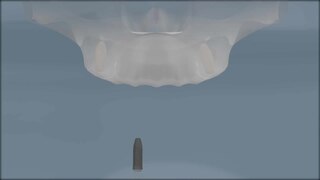
The term All-on-4, also known as All‐on‐Four and All‐in‐Four, refers to 'all' teeth being supported 'on four' dental implants, a prosthodontics procedure for total rehabilitation of the edentulous (toothless) patient, or for patients with badly broken down teeth, decayed teeth, or compromised teeth due to gum disease. It consists of the rehabilitation of either edentulous or dentate maxilla and / or mandible with fixed prosthesis by placing four implants in the anterior maxilla, where bone density is higher. The four implants support a fixed prosthesis with 10 to 14 teeth, and it is placed immediately, typically within 24 hours of surgery.

A dental torque wrench or restorative torque wrench is a torque wrench used to precisely apply a specific torque to a fastener bolt for fixation of an abutment, dentures or prosthetics on a dental implant.
A complete denture is a removable appliance used when all teeth within a jaw have been lost and need to be prosthetically replaced. In contrast to a partial denture, a complete denture is constructed when there are no more teeth left in an arch, hence it is an exclusively tissue-supported prosthesis. A complete denture can be opposed by natural dentition, a partial or complete denture, fixed appliances or, sometimes, soft tissues.

Overdenture is any removable dental prosthesis that covers and rests on one or more remaining natural teeth, the roots of natural teeth, and/or dental implants. It is one of the most practical measures used in preventive dentistry. Overdentures can be either tooth supported or implant supported. It is found to help in the preservation of alveolar bone and delay the process of complete edentulism.
The history of dental treatments dates back to thousands of years. The scope of this article is limited to the pre-1981 history.
A multi-unit abutment (MUA) is an abutment most commonly used with dental implants in "All-on-Four" protocols. They are designed for screw-retained group restorations, which are often used in combination with angled dental implants and whole arch replacements, as well as screw fixation of bridges made of zirconium or metal-ceramic group restorations to the implant.